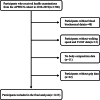Muscle mass rather than muscle strength or physical performance is associated with metabolic syndrome in community-dwelling older Chinese adults
- PMID: 33740914
- PMCID: PMC7980667
- DOI: 10.1186/s12877-021-02143-8
Muscle mass rather than muscle strength or physical performance is associated with metabolic syndrome in community-dwelling older Chinese adults
Abstract
Objective: The purpose of this study was to examine whether muscle mass, muscle strength, and physical performance were associated with metabolic syndrome (MetS) in community-dwelling older Chinese adults.
Methods: The study comprised of 1413 community-dwelling Chinese participants (577 men; mean ± standard deviation age: 71.3 ± 5.9) recruited from Tianjin and Shanghai, China who were invited to participate in a comprehensive geriatric assessment. The International Diabetes Federation metabolic syndrome guidelines were used to define MetS, including high waist circumference, elevated blood pressure, elevated fasting blood glucose, elevated triglycerides, and reduced HDL cholesterol. Muscle mass was measured by appendicular skeletal muscle mass/weight (ASM/weight), and ASM was measured by BIA. Muscle strength was measured using grip strength. Physical performance was represented by walking speed and the time up and go test (TUGT).
Results: The overall prevalence of MetS was 46.8% (34.1% in males and 55.5% in females). In the final logistic regression model, there was a significant, graded inverse association between muscle mass and MetS (p for trend = 0.014). Muscle strength and physical performance, including walking speed and TUGT, were not associated with overall MetS. In the components of MetS, muscle mass and grip strength were significantly inversely associated with high waist circumference and elevated blood pressure (p < 0.05), while physical performance was not associated with components of MetS.
Conclusions: Compared with muscle strength and muscle function, muscle mass was inversely associated with MetS in a community-dwelling elderly Chinese population. Among muscle mass、muscle strength and physical performance, muscle mass appears to have the strongest association with MetS in the elderly.
Keywords: Metabolic syndrome; Muscle mass; Muscle strength; Physical performance.
Conflict of interest statement
The authors declare that they have no competing interests.
Figures
Similar articles
-
Obesity, Even in the Metabolically Healthy, Increases the Risk of Poor Physical Performance: A Cross-Sectional Study of Older People in a Chinese Community.Clin Interv Aging. 2021 Apr 27;16:697-706. doi: 10.2147/CIA.S302167. eCollection 2021. Clin Interv Aging. 2021. PMID: 33948083 Free PMC article.
-
Metabolic syndrome and its association with components of sarcopenia in older community-dwelling Chinese.J Biomed Res. 2022 Feb 25;36(2):120-126. doi: 10.7555/JBR.36.20210143. J Biomed Res. 2022. PMID: 35322797 Free PMC article.
-
Relationship Between Physical Performance and Mild Cognitive Impairment in Chinese Community-Dwelling Older Adults.Clin Interv Aging. 2021 Jan 12;16:119-127. doi: 10.2147/CIA.S288164. eCollection 2021. Clin Interv Aging. 2021. PMID: 33469279 Free PMC article.
-
Effects of protein supplementation on lean body mass, muscle strength, and physical performance in nonfrail community-dwelling older adults: a systematic review and meta-analysis.Am J Clin Nutr. 2018 Nov 1;108(5):1043-1059. doi: 10.1093/ajcn/nqy192. Am J Clin Nutr. 2018. PMID: 30475963
-
Association between muscle strength and risk factors for metabolic syndrome in children and adolescents: a systematic review.J Pediatr Endocrinol Metab. 2020 Oct 14;34(1):1-12. doi: 10.1515/jpem-2020-0135. Print 2021 Jan 27. J Pediatr Endocrinol Metab. 2020. PMID: 33055312
Cited by
-
Muscle Mass Adjusted by Body Height is not Correlated with Mobility of Middle-Aged and Older Adults.Curr Dev Nutr. 2024 Jul 1;8(8):104412. doi: 10.1016/j.cdnut.2024.104412. eCollection 2024 Aug. Curr Dev Nutr. 2024. PMID: 39157007 Free PMC article.
-
Association of metabolic syndrome and frailty with postoperative complications in older gastric cancer patients: A body composition perspective.Cancer Med. 2024 Sep;13(18):e70194. doi: 10.1002/cam4.70194. Cancer Med. 2024. PMID: 39315666 Free PMC article.
-
Sex-specific associations between total and regional Fat-to-muscle Mass ratio and cardiometabolic risk: findings from the China National Health Survey.Nutr J. 2024 Sep 10;23(1):104. doi: 10.1186/s12937-024-01007-2. Nutr J. 2024. PMID: 39252042 Free PMC article.
-
The Added Value of Combined Timed Up and Go Test, Walking Speed, and Grip Strength on Predicting Recurrent Falls in Chinese Community-dwelling Elderly.Clin Interv Aging. 2021 Oct 5;16:1801-1812. doi: 10.2147/CIA.S325930. eCollection 2021. Clin Interv Aging. 2021. PMID: 34675495 Free PMC article.
-
Evaluating body composition, the eating behavior scale, and the healthy lifestyle index in female Jordanian adults with metabolic syndrome: a cross-sectional study.Diabetol Metab Syndr. 2025 Aug 7;17(1):318. doi: 10.1186/s13098-025-01757-x. Diabetol Metab Syndr. 2025. PMID: 40770371 Free PMC article.
References
-
- Lu J, Wang L, Li M, Xu Y, Jiang Y, Wang W, Li J, Mi S, Zhang M, Li Y, Wang T, Xu M, Zhao Z, Dai M, Lai S, Zhao W, Wang L, Bi Y, Ning G, 2010 China Noncommunicable Disease Surveillance Group Metabolic syndrome among adults in China: the 2010 China noncommunicable disease surveillance. J Clin Endocrinol Metab. 2017;102(2):507–515. doi: 10.1210/jc.2016-2477. - DOI - PubMed
Publication types
MeSH terms
LinkOut - more resources
Full Text Sources
Other Literature Sources
Medical


